(62284 products available)










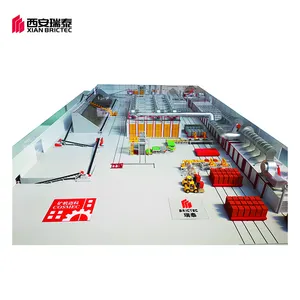










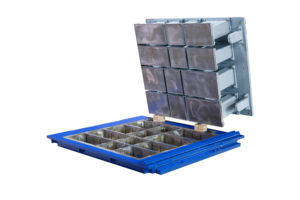


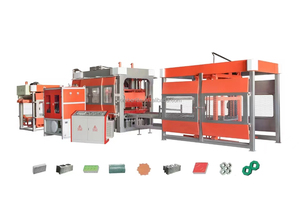



















































































































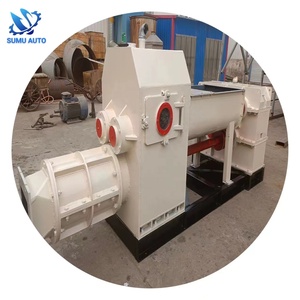
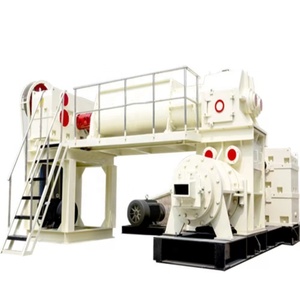










Clay brick making machinery refers to the equipment used to manufacture clay bricks for construction and other purposes.
Based on the different ways of producing bricks and features, the following types of clay brick making machines are available:
Extrusion machine:
The Extrusion machine is as an industrial brick production unit that adopts the extrusion method for shaping raw materials into bricks. This clay brick making machine comprises several key components, including a shredder, a pug mill, an extruder, a cutter, and control systems. Firstly, the shredder breaks up large chunks of clay into smaller pieces. Then, the pug mill homogenizes and adds the necessary moisture to the clay. Subsequently, the extruder forms the processed clay into a continuous strip or column. After that, the cutter severs the extruded clay into individual units. Finally, the control systems regulate the operation of the extrusion machine.
This machine suits large-scale brick manufacturing. By controlling temperature and pressure, it can produce bricks with diverse characteristics to meet different market needs, such as high strength, low expansion, and resistance to specific chemicals and thermal shocks.
Pressing machine:
The Pressing machine is a vital piece of equipment within a comprehensive brick production line. This machine is responsible for molding raw materials, such as clay or shale, into green bricks through the application of pressure. The green bricks subsequently undergo drying and firing processes to become finished bricks. The pressing machine comprises several key components, including a feeder, a pressing mechanism, a mold, a cutting system, and hydraulic and control systems.
The feeder serves to evenly distribute the material into the pressing area. Subsequently, the material is compacted and formed into green bricks using the pressing mechanism and mold. Then, the cutting system sections the molded material into individual green bricks. Hydraulic systems provide the necessary force for pressing, while control systems regulate the entire pressing process.
This machine is suitable for clay with high plasticity. It can improve the brick's density and strength by pressing.
Vacuum dewatering machine:
The vacuum dewatering machine plays a crucial role in the brick production line by reducing the moisture content of raw materials to an appropriate level for molding. This machine operates by creating a vacuum that extracts water from the material. The vacuum dewatering machine consists of several key components, including a vacuum pump, a tank, a filtration system, and a conveyer system.
The tank receives the material, and the vacuum pump establishes a vacuum within the tank. The water is then extracted from the material through a filtration system. Finally, the conveyer system transports the processed material to the subsequent operational stage.
The moisture content of raw materials is reduced by this machine through the application of vacuum pressure and filtration. Consequently, the efficiency and quality of subsequent processing stages are improved.
Regular maintenance and timely repairs of the machinery are critical to ensuring proper functioning and prolonging their service life.
Both manual and automatic clay brick machines are used to produce bricks for construction projects. The following are some common applications for these machines.
Construction Industry
Both types of machines produce bricks used for durable buildings, including homes, schools, hospitals, and commercial centers. Different types of bricks are made to meet architectural needs and comply with regional building standards.
Landfill Projects
Landfill facilities use brick-making machines to convert waste materials into useful bricks for landscaping, paths, or containment structures.
Underground Mining
Minimizing the impact of mining operations is critical to keeping the environment intact. Clay brick-making machines can create support pillars or backfill using mined clay material, reducing waste and improving sustainability.
Soil Conservation
Bricks produced by an automatic clay brick machine may be used for conservation efforts, such as terracing, gully plugs, or check dams, helping to control erosion and promote soil retention.
Rapid Urbanization
The fast growth of cities creates a pressing need for construction materials. Fully automated brick-making machines produce large quantities of bricks efficiently to meet the high demand for infrastructure development in urban areas.
Here's a brief guide to help business buyers choose the best quality clay brick machine:
Consider the demand for bricks
First, identify the local demand for bricks after buying the clay brick machine. The business may need a large-capacity machine if there is a high demand for bricks. Such large-capacity machines produce over 15,000 pieces of bricks daily. They are the twin-shaft machine, the small tunnel kiln machine, and the circular hybrid kiln machine. Large-capacity machines also have high automation. Consider lower automation and large capacity for low demand. A single-shaft machine or a clay brick machine with a vertical kiln may be adequate. They are more cost-effective for areas with low brick demand.
Assess the availability of clay soil
Next, consider the type of soil that is available to the business. Some soil types are unsuitable for making bricks. A business will need to get its clay from far if its local soil isn't clay-based. In such cases, a semi-automatic brick-making machine or an intermediate machine with manual operation may be better. Choosing a machine that uses soil creatively will lead to cost savings. The soil it uses may be closer to the factory.
Evaluate energy sources
The type of kiln used to fire the bricks affects the energy consumption of the machine. Consider the energy source used for firing. Some machines burn coal, while others use gas or electricity. Coal-fired kilns use a lot of energy and may go up to 30% of energy use. Gas-electric machines are more efficient and may use up to 10%. Consider the machine that matches the type of energy source used in the area.
Determine budget constraints
Business buyers have to consider budget constraints. Fully automated machines with high output are more costly. They may take up a large part of the budget. Lower-automation machines are more affordable. Consider all aspects of the business when choosing the more automated or less automated machine.
Focus on the long-term cost of far more energy, clay, and operation
Q1:What types of clay require special clay brick making machinery?
A1: Special clay brick making machines are required for particular clays. The consistent and accurate mixing over a long time is necessary for highly plastic clay. Sandy clay can use standard brick machines as it contains sand, which makes the clay less plastic. Stiff clay can be processed with traditional extrusion machines because it is more challenging and needs more force to shape it.
Q2:Do clay brick-making machines use fuel or electricity?
A2:Electricity is used during the drying and firing stages of brick production, while fuel is used to power the brick-making machines. The type of fuel used to power the clay mixing and extrusion may vary, as may the firing fuel. Sometimes coal is used to create tunnels in the brick kiln that are then used to fire the bricks.
Q3:Do fully automatic clay brick making machines have a high rate of failure?
A3:Fully automatic machines have fewer failures than semi-automatic or manual machines. This is because the automatic feeding of materials into the machine reduces the entry points for error. However, they are more expensive and harder to repair than those with some manual processes.